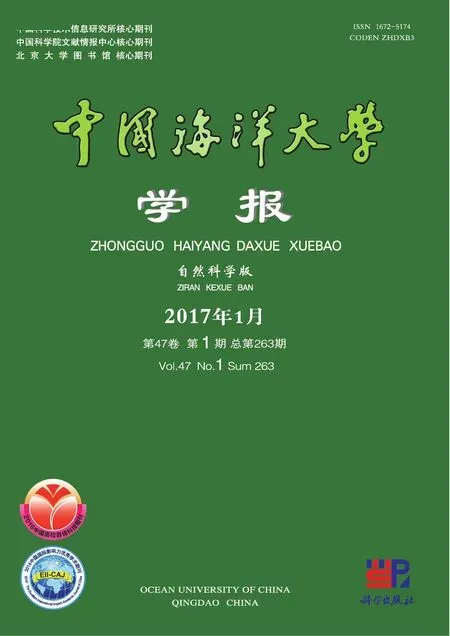中国近海环境中三丁基锡水质基准推导与生态风险初步评价❋
2017-01-06张京京范家诚李正炎
张京京, 管 博, 范家诚, 李正炎,2❋❋
(1.中国海洋大学环境科学与工程学院,山东 青岛 266100;2.中国海洋大学海洋环境与生态教育部重点实验室,山东 青岛 266100)
中国近海环境中三丁基锡水质基准推导与生态风险初步评价❋
张京京1, 管 博1, 范家诚1, 李正炎1,2❋❋
(1.中国海洋大学环境科学与工程学院,山东 青岛 266100;2.中国海洋大学海洋环境与生态教育部重点实验室,山东 青岛 266100)
中国近海环境中三丁基锡化合物(TBT)的广泛使用对海洋生物产生了一定危害,但中国目前还没有建立相关的水质基准或标准,妨碍了该污染物的生态风险评价。本文根据文献筛选得到的59种生物的急性毒性数据和29种生物的慢性毒性数据,采用物种敏感性分布模型推导了中国TBT的海水水质基准,在此基础上,应用商值法和概率风险评价法对中国沿海地区水体中的TBT进行了初步生态风险评价。结果表明,中国近海环境中TBT的急性和慢性水质基准分别为0.137和0.006μg/L;两种评价方法结果均表明中国近海水体存在一定的风险,并且慢性风险远高于急性风险。因此中国近海环境中TBT的生态风险需要进一步关注。
三丁基锡;水质基准;物种敏感度分布法;生态风险评价;沿海水体
1960年代以来,有机锡被广泛应用于海洋船舶防污涂料、PVC稳定剂、催化剂、防腐剂和杀虫剂。有机锡是迄今为止引入海洋环境中毒性最大的化合物之一,其中三丁基锡化合物(Tributyltin,TBT)在有机锡化合物中毒性最大。TBT对海洋中多种生物有着长期有效的杀生效果,同时也对各种非目标生物产生毒害作用[1]。研究表明,1 ng/L的TBT可导致海产腹足类发生性畸变,2 ng/L的TBT会抑制太平洋牡蛎(Crassostreagigas)的钙代谢,而当TBT浓度达到300 ng/D时,可对多数水生生物产生明显的内分泌毒性效应[2-4]。TBT具有脂溶性,易在生物体内富集,其在蓝贝(Mytilussp.)体内的生物富集系数可高达100 000[5-6]。作为一种内分泌干扰物,TBT会干扰水生生物体内性激素的产生、释放、代谢、排泄等过程,进而影响生物的生殖功能[7]。因此,研究TBT在中国沿海水体中的分布并对其进行生态风险评价是很有必要的。
美国环境保护署(U.S Environmental Protection Agency)将生态风险评价(Ecological Risk Assessment, ERA)定义为“评估由于一种或多种外界因素导致可能发生或正在发生的不利生态影响的过程”[8]。目前,用于生态风险评估的方法主要有商值法和概率生态风险评估法。2003年,欧盟委员会颁布了《风险评价技术导则》(Technical Guidance Document on Risk Assessment, TGD),该导则详细介绍了推导污染物水环境质量基准(WQC)即预测无效应浓度值(Predicted NoEffect Concentration, PNEC)的方法和应用风险商(Risk Quotient, RQ)对生态风险进行表征的方法[9]。商值法是目前国际上应用最为广泛的确定性风险评估方法[10],是一种“点估计”方法。概率生态风险评估(PERA)可以将风险评价结论以连续分布曲线的形式得出,综合考虑暴露浓度和效应浓度的变异性和不确定性,对污染的生态风险作出整体评价[11],包括联合概率曲线法及概率风险商等方法。
风险商为预测环境浓度值(Predicted Environmental Concentration, PEC)与PNEC的比值(RQ=PEC/PNEC),其中的PEC可以通过模型预测或者实地监测得到,而PNEC可以通过两种方法计算得到,即物种敏感度分布法(Species Sensitivity Distribution, SSD)和评价因子法(Assessment Factor, AF)[12]。SSD法是美国和欧洲1970年代发展起来的用于评估生态风险的方法[13]。在理论上,SSD法认为生态系统中的不同物种由于生理或地域等特征的不同而对同一剂量的同一污染物有着不同的剂量-效应关系,即不同的物种对同一污染物存在着敏感性差异,而这些敏感性差异遵循某种概率分布(物种敏感性分布)。将不同物种对某种污染物的敏感性分布进行函数拟合,通过计算即可求得能够保护一定百分比物种的污染物浓度,进而推算出基准阈值[14-15]。评价因子法比较简单,但该方法不能充分利用所收集的数据,推导出的结果容易产生偏差,存在很大的不确定性,因此一般在毒性数据量较少不能满足物种敏感性分布法时使用。
水质基准(Water Quality Criteria, WQC)是水环境质量基准的简称,指水体中各物质成分对水环境中的特定对象(水生生物或人)不产生有害效应的最大浓度或剂量[16]。美国制定的水质基准是双值基准,包括基准最大浓度(CriteriaMaximum Concentration, CMC)和基准连续浓度(Criteria Continuous Concentration, CCC)。其中,基准最大浓度考虑的是短期内的急性毒性效应,而基准连续浓度考虑的则是长期的慢性毒性效应。双值基准在某些情况下(例如短期暴露)允许水生生物体内污染物的含量超过基准连续浓度但又不对该生物体产生不可接受的影响,从而避免“过保护”的问题,因此,双值水质基准被越来越多的人采用[17-18]。国外一些发达国家在几十年前就已经展开了水质基准研究工作,并且形成了较为系统的水质基准研究体系,而中国的水质基准研究工作开始较晚[19]。近几年中国一些研究者开始了水质基准和风险评估研究工作,并取得了一些成果[20-23]。
到目前为止,美国和加拿大等国家已经制定了TBT海水水质基准[24-25],而我国还没有发布水体中TBT基准或标准的相关文件,有关TBT水质基准的研究报道也很少,穆景利等[26]虽然通过SSD法推导出了我国海水水质基准高值和水质基准低值,但其选用的毒性数据涵盖了淡水物种的毒性数据。美国环保署规定淡水生物的毒性数据不能用于推导海水水质基准[27]。笔者认为这样推导出的水质基准不适用于海水环境。因此,本文选取海水物种毒性数据,通过SSD模型推导我国的TBT海水水质基准,并在此基础上分别用商值法和概率生态风险评估法对我国近海环境中的TBT进行生态风险评价。
1 方法和过程
1.1 毒性数据的筛选
本文所采用的毒性数据来源于美国环保署ECOTOX毒性数据库(http://cfpub.epa.gov/ecotox/)、中国知网(http:// www.cnki.net/)和相关公开文献。对毒性数据的筛选主要考虑了其可靠性、精确性和适当性原则[28]。为保证所建立的水质基准符合中国海水生物区系特征,本文所选物种均广泛分布于中国沿海,包括本地物种和已经在中国成功养殖并广泛分布的物种。在所选用的数据中,用于毒性试验所使用的TBT化合物主要是三丁基氯化锡(TBTCl)和三丁基氧化锡(TBTO)。
在急性毒性数据获取中,无脊椎动物选取的指标为48 h LC50或EC50(半数致死浓度或半数效应浓度),而脊椎动物和藻类选取的指标为96 h LC50或EC50,在没有符合条件的情况下再选择其他时间的毒性终点,但均不超过96 h。在慢性毒性数据获取中,选取的脊椎动物、无脊椎动物和藻类的暴露时间分别为≥14、≥7和≥3 d,慢性毒性数据的终点是生长或繁殖的NOEC(无观察效应浓度),如果没有可用的NOEC则用 1/2LOEC(最低可观察效应浓度)代替,当对同一物种有多个可供选择的毒理数据时,则选择暴露时间最长的 NOEC。对于同一物种、同一暴露时间和同一暴露终点的不同毒理数据则选择这些数据的几何均值。
1.2 SSD模型的拟合
SSD法是以不同生物的毒性数据(LC50/EC50/NOEC等)的对数值为横坐标,以每个数值的累积概率为纵坐标做散点图,然后选择一个曲线模型对其进行拟合即得到SSD曲线[29]。可用的曲线模型有log-triangular、log-normal和log-logistic等,本文选用的是应用范围较广的log-normal分布模型,因为在该模型中每个毒性数据都参与基准值的定值,在某种程度上减轻了个别异常低值对最后水质基准定值的影响[26]。本文利用荷兰公共健康和环境研究所研发的ETX 2.0软件对筛选的数据进行处理[30]。应用Anderson-Darling检验(A-D检验)和Kolmogorov-Sminov 检验( K-S检验)对经对数转换的毒性数据的正态分布拟合度进行检验。根据得到的SSD曲线来估计该污染物的危害浓度(Hazardous Concentriation, HCp)。HCp表示在此浓度下,生境中p%的生物会受到影响,而(100-p)%的生物是相对安全的[13,31],通常,危害浓度值选取HC5。根据欧盟委员会颁布的《风险评价技术导则》(TGD),水体的PNEC可以通过下面的公式计算得到:
PNEC= HC5/AF。
其中AF为评价因子,反映数据的不确定性,其取值范围为1~5[9]。本文根据所选物种的代表性、数据的质量和数量及模型的拟合度将急性数据和慢性数据的AF均选为2。
1.3 生态风险评价
1.3.1 商值法 本文首先利用商值法(RQ=PEC/PNEC)对水体中的TBT进行生态风险评估。由于我国沿海水体中TBT的相关数据不足,本文选用中国沿海水体中TBT的实测浓度(Measured Environmental Concentration, MEC)取代PEC进行生态风险评价。某一区域的急性和慢性风险商分别利用该区域TBT浓度的最高值和平均值计算得到。风险等级的划分依据为:当RQ<0.1时,表明水环境处于低风险状;当0.1≤RQ≤1时,表明水环境处于中度风险状态;当RQ>1时,表明水环境处于高度风险状态[32-33]。
1.3.2 概率风险评价法 概率风险评价法通过分析暴露浓度与毒性数据的概率分布曲线,考察污染物对生物的毒害程度,从而确定污染物对生态系统的风险。本文选用联合概率曲线法用ETX 2.0软件以污染物暴露浓度的累积函数为横坐标,以受影响物种的比例为纵坐标作图[22]。由联合概率曲线与横坐标轴之间的面积来表征污染物的生态风险,该面积可用ETX2.0软件计算。由TBT的急性毒性数据和各个区域TBT暴露浓度的最大值得出急性联合概率曲线,由TBT的慢性毒性数据和各个区域TBT暴露浓度的平均值得出慢性联合概率曲线。
2 结果与讨论
2.1 TBT毒性数据
筛选出的TBT急性毒性数据涵盖藻类、轮虫、环节、节肢、棘皮、软体和脊索等七大生物门类的59种生物(见表1)。急性毒性最大值出现在硅藻门下的丹麦细柱藻,为122μg/L,最小值出现在节肢动物门下的糠虾,为0.374μg/L。慢性毒性数据涵盖藻类、节肢、轮虫、软体、棘皮和脊索等六大门类的29种生物(见表2)。慢性毒性最大值也出现在硅藻门下的丹麦细柱藻,为100μg/L,最小值出现在节肢动物门下的汤氏纺锤水蚤,为0.009μg/L。没被采用的数据未列出。
2.2 TBT的海水水质基准
应用log-normal模型将表1和表2中的毒性数据拟合成SSD曲线,急性毒性数据和慢性毒性数据的SSD曲线分别对应图1和图2。根据SSD曲线可推导出TBT急、慢性毒性终点的HC5分别为0.273和0.011μg/L,对应的95%置信区间分别为0.157~0.426μg/L和0.003~0.027μg/L。根据HC5和评价因子可以得到海水中TBT的急性水质基准和慢性水质基准分别为0.137和0.006μg/L。
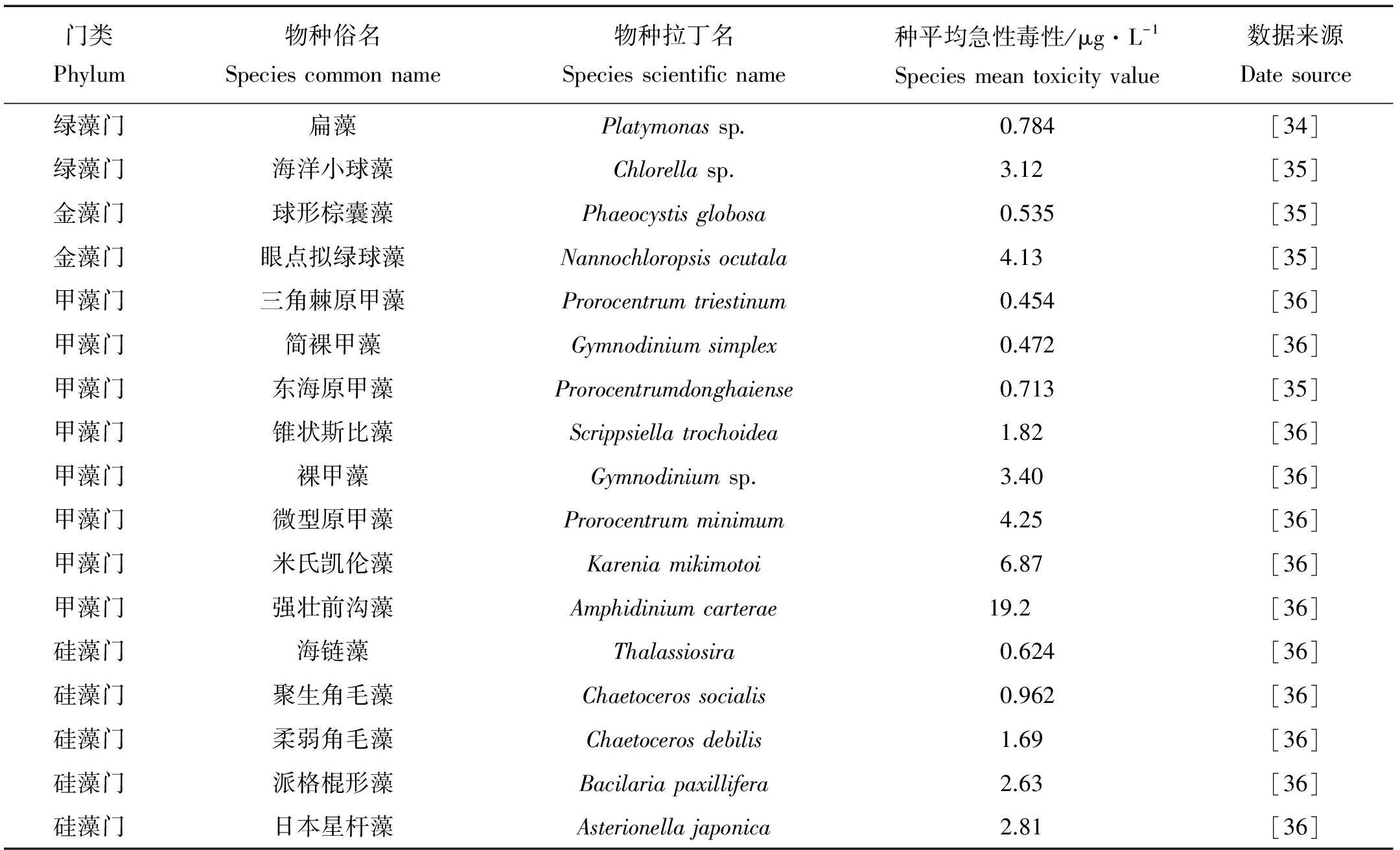
表1 三丁基锡对海水生物的急性毒性数据
续表1
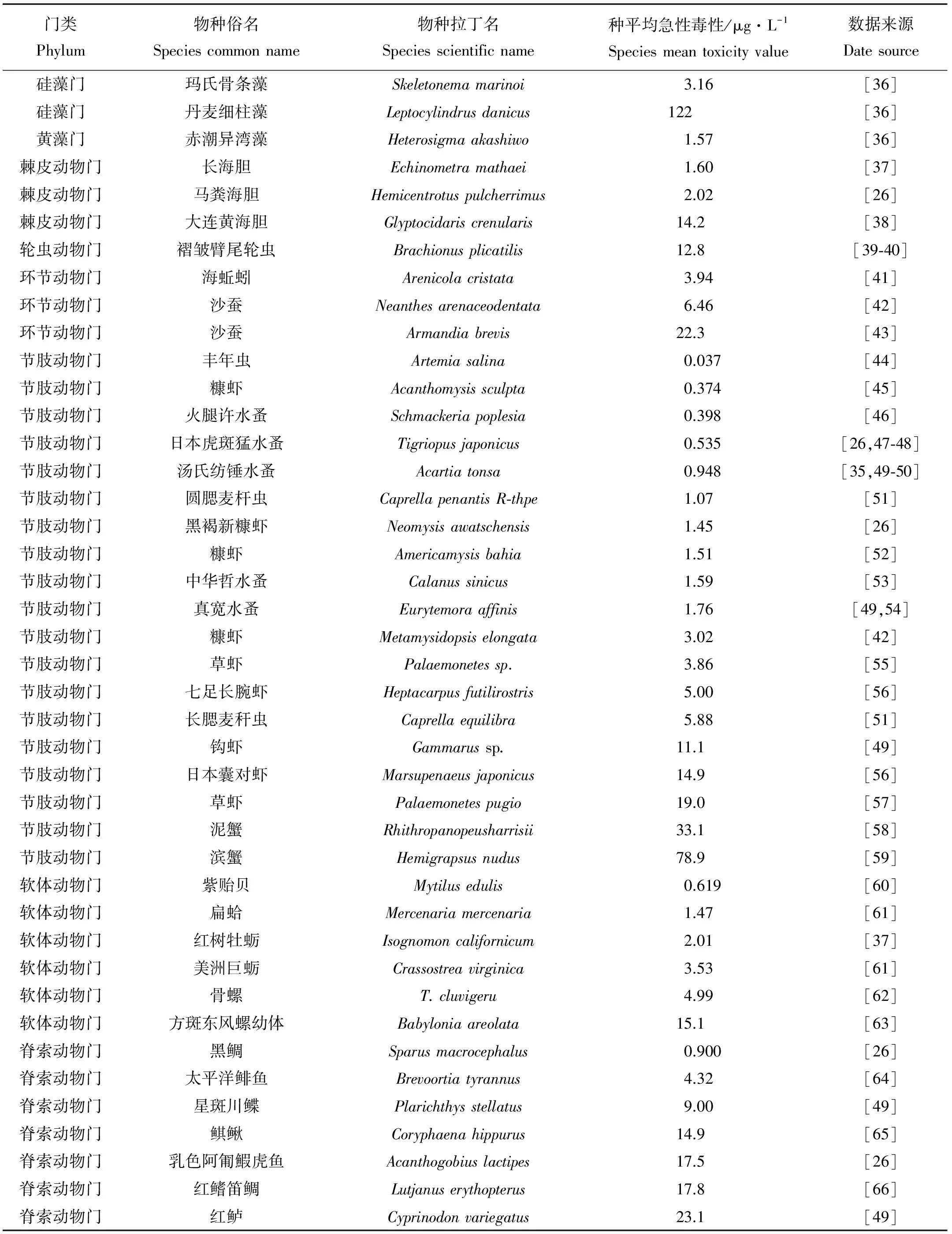
门类Phylum物种俗名Speciescommonname物种拉丁名Speciesscientificname种平均急性毒性/μg·L-1Speciesmeantoxicityvalue数据来源Datesource硅藻门玛氏骨条藻Skeletonemamarinoi3.16[36]硅藻门丹麦细柱藻Leptocylindrusdanicus122[36]黄藻门赤潮异湾藻Heterosigmaakashiwo1.57[36]棘皮动物门长海胆Echinometramathaei1.60[37]棘皮动物门马粪海胆Hemicentrotuspulcherrimus2.02[26]棘皮动物门大连黄海胆Glyptocidariscrenularis14.2[38]轮虫动物门褶皱臂尾轮虫Brachionusplicatilis12.8[39⁃40]环节动物门海蚯蚓Arenicolacristata3.94[41]环节动物门沙蚕Neanthesarenaceodentata6.46[42]环节动物门沙蚕Armandiabrevis22.3[43]节肢动物门丰年虫Artemiasalina0.037[44]节肢动物门糠虾Acanthomysissculpta0.374[45]节肢动物门火腿许水蚤Schmackeriapoplesia0.398[46]节肢动物门日本虎斑猛水蚤Tigriopusjaponicus0.535[26,47⁃48]节肢动物门汤氏纺锤水蚤Acartiatonsa0.948[35,49⁃50]节肢动物门圆腮麦杆虫CaprellapenantisR⁃thpe1.07[51]节肢动物门黑褐新糠虾Neomysisawatschensis1.45[26]节肢动物门糠虾Americamysisbahia1.51[52]节肢动物门中华哲水蚤Calanussinicus1.59[53]节肢动物门真宽水蚤Eurytemoraaffinis1.76[49,54]节肢动物门糠虾Metamysidopsiselongata3.02[42]节肢动物门草虾Palaemonetessp.3.86[55]节肢动物门七足长腕虾Heptacarpusfutilirostris5.00[56]节肢动物门长腮麦秆虫Caprellaequilibra5.88[51]节肢动物门钩虾Gammarussp.11.1[49]节肢动物门日本囊对虾Marsupenaeusjaponicus14.9[56]节肢动物门草虾Palaemonetespugio19.0[57]节肢动物门泥蟹Rhithropanopeusharrisii33.1[58]节肢动物门滨蟹Hemigrapsusnudus78.9[59]软体动物门紫贻贝Mytilusedulis0.619[60]软体动物门扁蛤Mercenariamercenaria1.47[61]软体动物门红树牡蛎Isognomoncalifornicum2.01[37]软体动物门美洲巨蛎Crassostreavirginica3.53[61]软体动物门骨螺T.cluvigeru4.99[62]软体动物门方斑东风螺幼体Babyloniaareolata15.1[63]脊索动物门黑鲷Sparusmacrocephalus0.900[26]脊索动物门太平洋鲱鱼Brevoortiatyrannus4.32[64]脊索动物门星斑川鲽Plarichthysstellatus9.00[49]脊索动物门鲯鳅Coryphaenahippurus14.9[65]脊索动物门乳色阿匍鰕虎鱼Acanthogobiuslactipes17.5[26]脊索动物门红鳍笛鲷Lutjanuserythopterus17.8[66]脊索动物门红鲈Cyprinodonvariegatus23.1[49]
注:表中所列均为换算成TBT以后的浓度值。
Note: The toxicity values were given as TBT content.
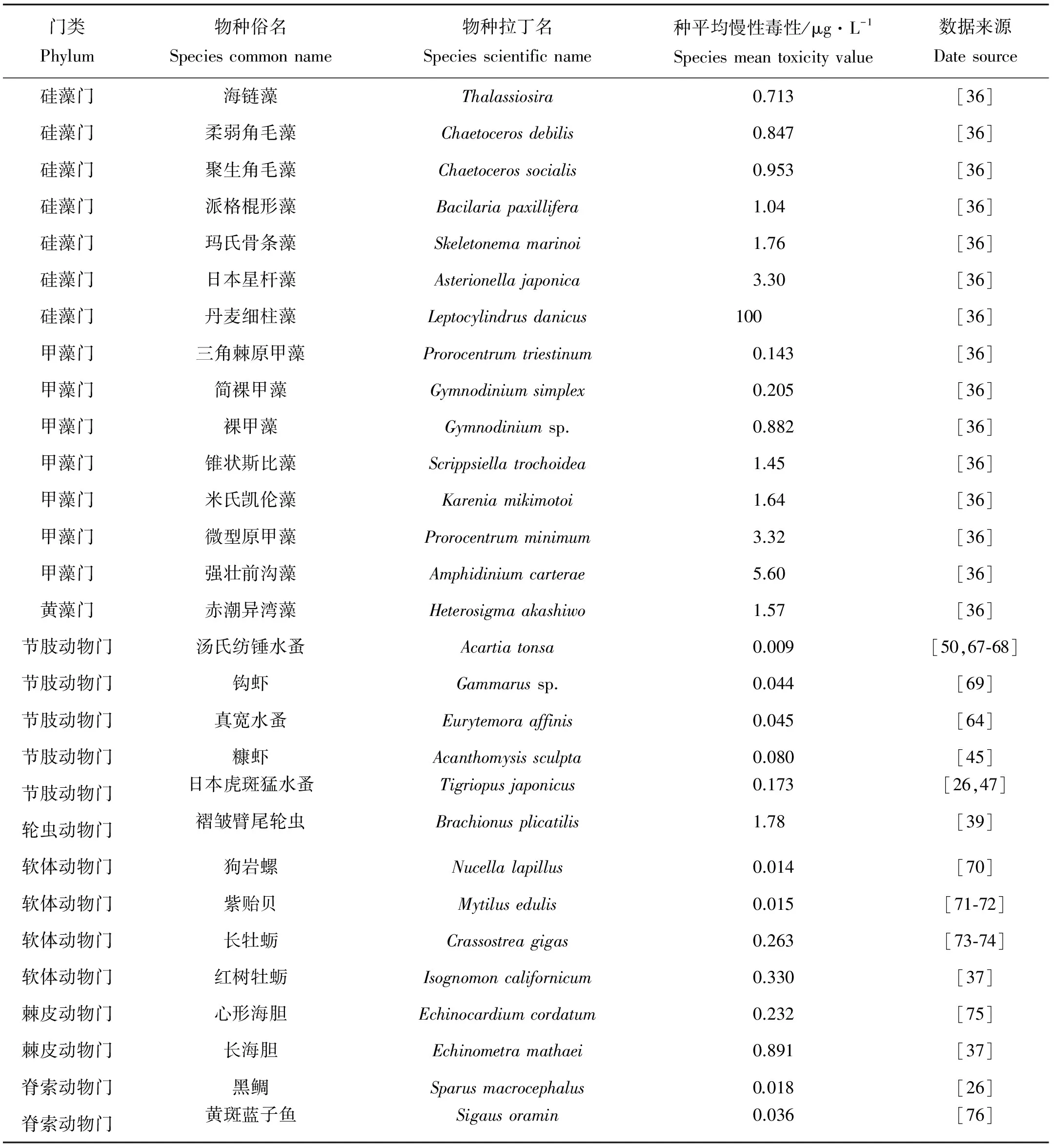
表2 三丁基锡对海水生物的慢性毒性数据
注:表中所列均为换算成TBT以后的浓度值。
Note: The toxicity values were given as TBT content.
表3对不同国家的TBT海水水质基准进行了比较,本文研究所得的海水TBT慢性基准值与美国慢性基准值相当,急性基准值约为美国急性基准值的二分之一。产生这种差异的原因可能有以下两个方面:一方面,美国在推导急性水质基准时没有考虑藻类的毒性数据;另一方面,中国和美国生态系统中的生物存在地域性差异,因而会引起物种敏感性的不同,从而导致生物对TBT毒性效应的反应程度不同。本研究推导出的TBT慢性基准值比加拿大公布的TBT慢性基准值高很多,原因主要是两者采用的推导方法不同。加拿大的推导方法为评价因子法,其水质基准由最敏感物种的毒性效应值除以评价因子10得到,该方法得出的基准值主要取决于最敏感物种的毒性值,结果有很大的不确定性。本文则采用物种敏感度分布法,得出的结果更具有说服力。
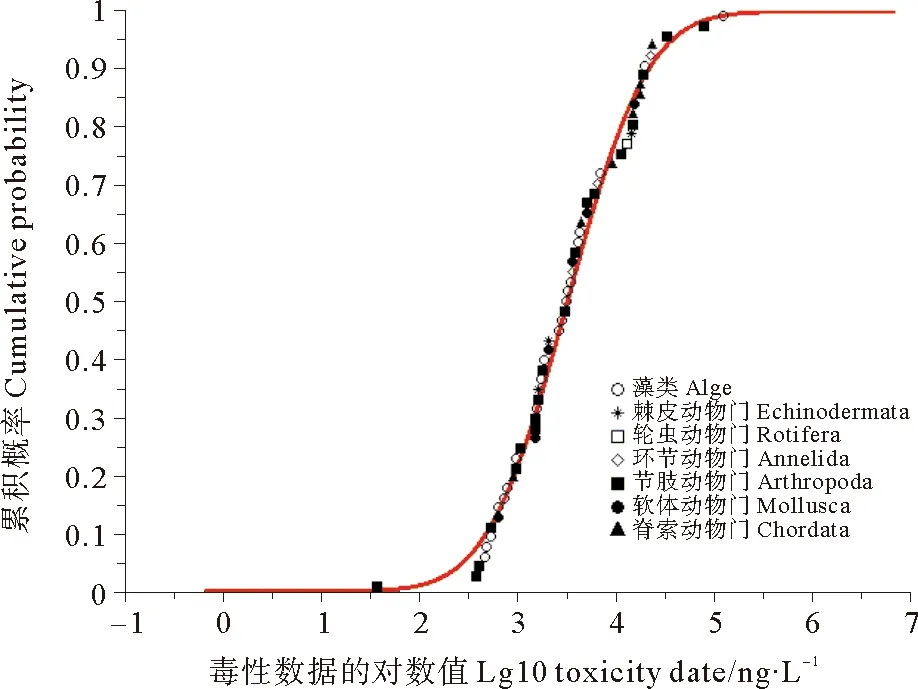
图1 TBT 的海水急性物种敏感性分布曲线

/μg·L-1
Note:①China;②Ainerica;③Canada
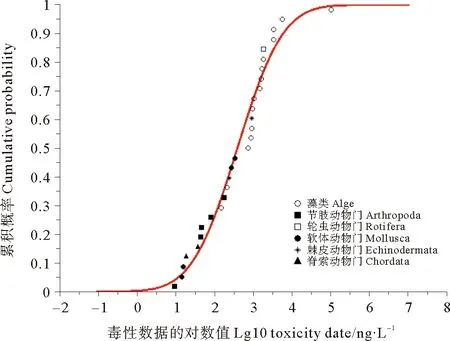
图2 TBT 的海水慢性物种敏感性分布曲线
2.3 中国沿海水体中TBT的生态风险评价结果
本研究从已发表的文献及相关资料中搜集到中国沿海水体中TBT的环境暴露水平,其浓度范围从低于检测限至8.73μg/L不等,其中最高值出现在广东惠阳港。各研究区域的具体位置以及TBT的浓度范围和平均值见表4。
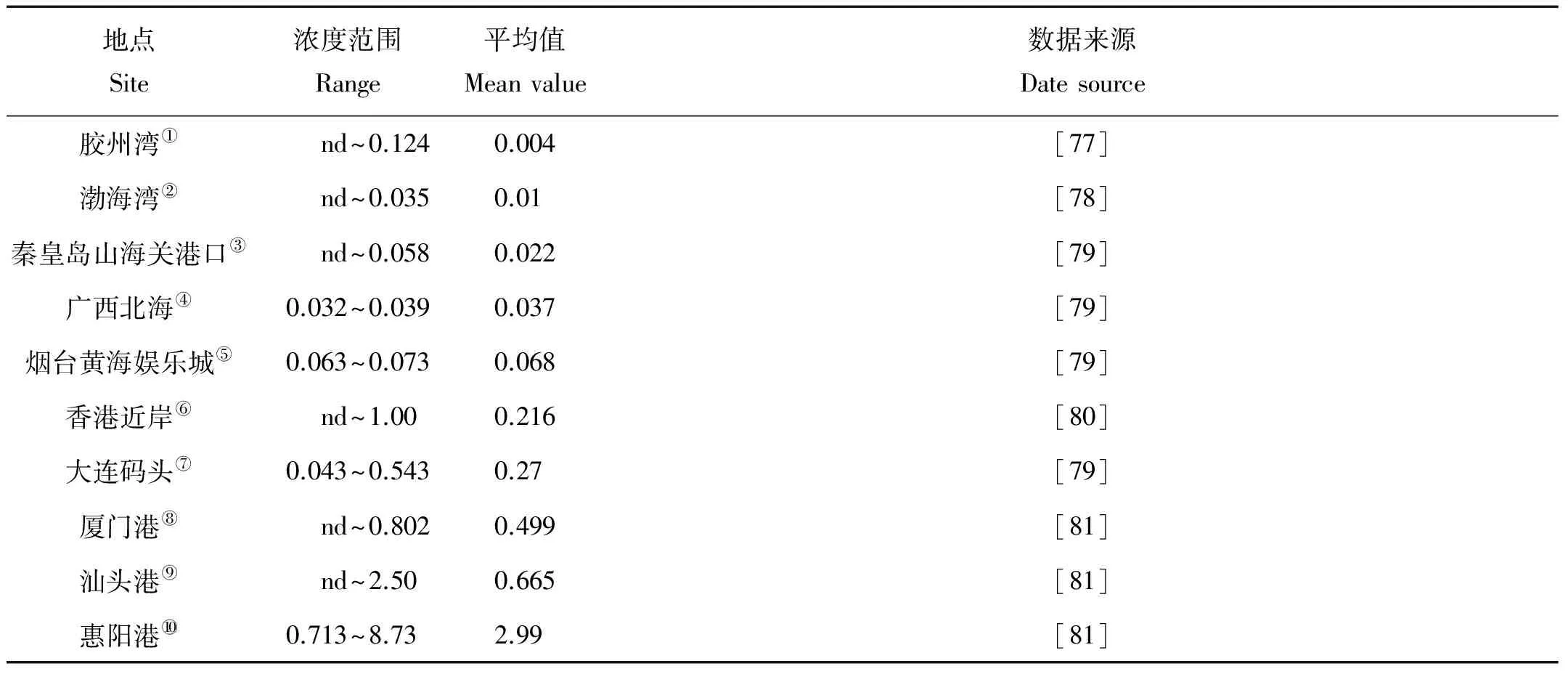
表4 中国沿海水体三丁基锡的浓度分布
注:“nd”表示低于检测限。“nd”means not been detected
①Jiaozhou Bay; ②Begau Bay; ③Shanhaiguan Port; ④Beihai; ⑤Yantai; ⑥Hongkong; ⑦Dalian; ⑧Xiamen Port; ⑨Shantou Port; ⑩Huiyang Port
2.3.1 商值法评价结果 图3详细描述了中国部分沿海地区的TBT急性风险商和慢性风险商。急性风险商范围为0.25~63.7,平均为10.1;慢性风险商的范围为0.67~498,平均为79.7;急性和慢性高风险区域分别占所研究区域的50%和90%;急性风险商和慢性风险商的最高值均出现在广东惠阳港,主要是因为惠阳港南段与大亚湾相邻,是广东省著名的天然深水港,拥有大规模的石化码头,2 000年吞吐量达5 000万t[82]。所研究的10个地区均存在不同程度的风险。从图3可以看出,东北部的秦皇岛山海关港口、渤海湾、烟台黄海娱乐城和胶州湾均处在急性中等风险状态,而东南部的厦门港、汕头港、惠阳港和香港近岸则处在急性高风险状态,主要是因为中国东南部沿海地区经济比较发达,船舶流通量大,而船舶防污漆的使用是海洋环境中TBT化合物的主要来源[83]。除了胶州湾处于慢性中等风险状态以外,另外9个地区均处在慢性高风险状态,并且慢性风险商要远高于急性风险商,主要是因为TBT毒性大,即使其在水体中的浓度很低,经过长期的作用也会对生物体产生严重的危害。
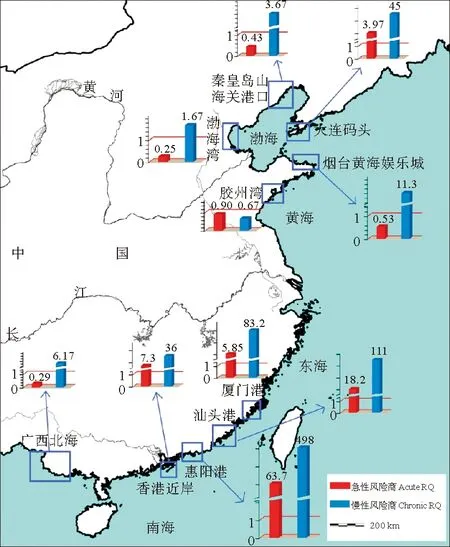
图3 中国沿海水体TBT的生态风险商值分布
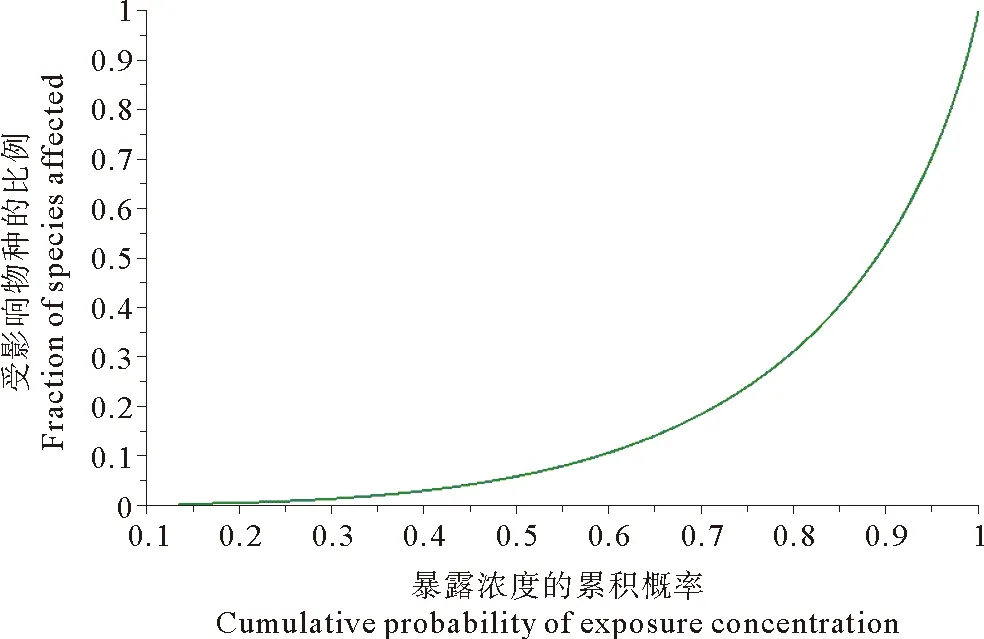
图4 TBT对水生生物的急性联合概率曲线
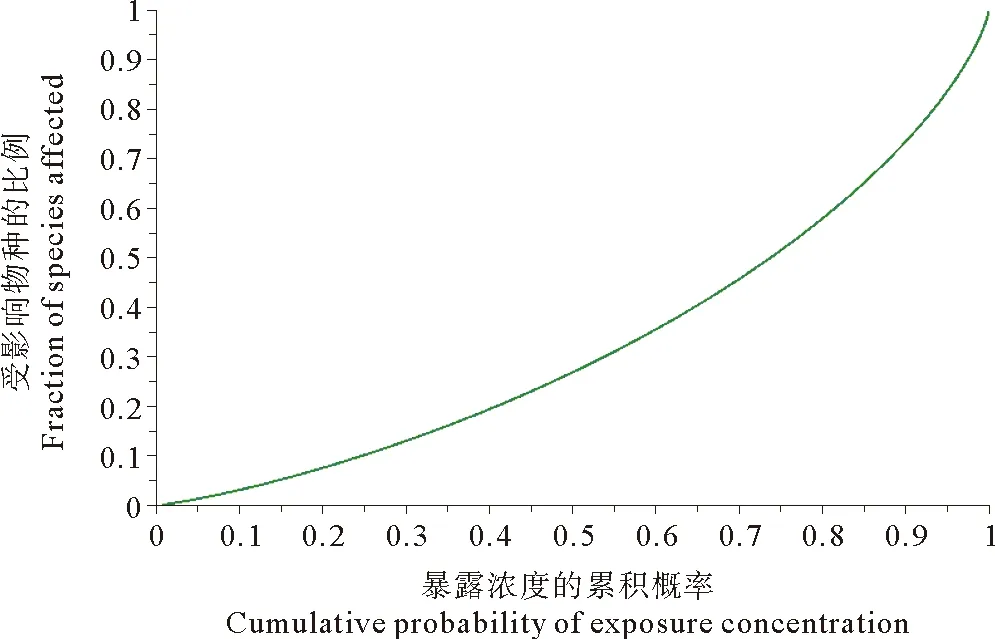
图5 TBT对水生生物的慢性联合概率曲线
2.3.2 概率风险评价结果 经检验中国近海环境中TBT经log对数转化后的暴露浓度服从正态分布。图4和5分别为中国近海水体中TBT 对水生生物的急性和慢性联合概率曲线。曲线离横坐标轴越近代表生态风险越低。由联合概率曲线和横坐标轴之间的面积可得出中国近海水体急性和慢性风险值分别为16.64%和32.92%,表明水体存在一定的风险。一般认为,当水体中受影响的物种超过5%时表明该水体存在生态风险[84]。从图中可以看出,中国近海水体中超过60%的水体存在急性风险,超过90%的水体存在慢性风险,且慢性风险高于急性风险,与商值法得到的结论相一致。
3 结语
三丁基锡化合物在中国的广泛使用及其对各种生物的不利影响,使其受到越来越多的关注。中国迄今尚未建立TBT的海水水质基准。本研究筛选了中国本地物种的急性和慢性毒性数据并建立了SSD模型,根据模型拟合,推导出中国海水水体TBT的急性和慢性水质基准分别为0.137和0.006μg/L。根据推导出的水质基准,分别应用商值法和概率风险评价法对中国部分沿海地区水体中的TBT进行生态风险评价。两种评价方法的结果均表明,中国近海水体存在生态风险,并且慢性风险远高于急性风险。由商值法得出的结果表明,急慢性风险商最高值均出现在广东惠阳港,急性和慢性高风险地区分别占所研究区域的50%和90%。由概率风险评价法得出急性和慢性风险地区所占比例分别超过60%和90%。由此可以看出,TBT在我国沿海地区已广泛分布,其生态风险需要进一步关注。
[1] Jr H L, Pinkney A E. Acute and sublethal effects of organotin compounds on aquatic biota: An interpretative literature evaluation[J]. Critical Reviews in Toxicology, 1985, 14(2): 159-209.
[2] Chagot D, Alzieu C, Sanjuan J, et al. Sublethal and histopathological effects of trace levels of tributyltin fluoride on adult oysterCrassostreagigas[J]. Aquatic Living Resources, 1990, 3(2): 121-130.
[3] Hoch M. Organotin compounds in the environment. An overview [J]. Applied Geochemistry, 2001, 16: 719-743.
[4] Axiak V, Micallef D, Muscat J, et al. Imposex as a biomonitoring tool for marine pollution by tributyltin:some further observations [J]. Environment International, 2003, 28(8): 743-749.
[5] 高峻敏, 郑泽根. 环境系统中有机锡化合物的分布和归宿[J].上海环境科学, 2003, 22(增刊): 20-25. Gao J. Distribution and fate of organotin compounds in environmental system[J]. Shanghai Environmental Sciences, 2003, 22(susupment): 20-25.
[6] Salazar M H, Salazar S M. Mussels as Bioindicators: Effects of TBT on Survival, Bioaccumulation, and Growth Under Natural Conditions[M]. London: Springer Netherlands, 1996: 305-330.
[7] Kavelock R J. Research needs for risk assessment of health and environment effects of endocrine disrupters, a report of the U.S.EPA-Sponsored Workshop[J]. Environ Health Perspect, 1996, 104(4): 715-740.
[8] US EPA.Guidelines for Ecological Risk Assessment,U.S[J].Federal Register, 1996: 61.
[9] ECB(European Chemicals Bureau). Technical Guidance Document on Risk Assessment[M].Brussels: European Commission Joint Research Center, 2003.
[10] Lin Z, Siyu Z, Xin D, et al. Probabilistic ecological risk assessment of polycyclic aromatic hydrocarbons in southwestern catchments of the Bohai Sea, China.[J]. Ecotoxicology, 2013, 22(8):1221-31.
[11] Solomon K R, Paul S. New concepts in ecological risk assessment: where do we go from here?[J]. Marine Pollution Bulletin, 2002, 44(4): 279-85.
[12] 冯承莲, 赵晓丽, 侯红, 等. 中国环境基准理论与方法学研究进展及主要科学问题[J]. 生态毒理学报, 2015, 10(1): 2-17. Feng C L, Zhao X L, Hou H, et al. Research progress and main scientific problems of theory and methodology of Chinas Environmental Quality Criteria[J]. Asian Journal of Ecotoxicology, 2015, 10(1): 2-17.
[13] Kooijman S A L M. A safety factor for LC 50 values allowing for differences in sensitivity among species[J]. Water Research, 1987, 21(3): 269-276.
[14] 吴丰昌, 孟伟, 曹宇静, 等. 镉的淡水水生生物水质基准研究[J]. 环境科学研究, 2011, 24(2): 172-183. Feng-Chang W U, Wei M, Cao Y J, et al. Derivation of aquatic life water quality criteria for cadmium in freshwater in China[J]. Research of Environmental Sciences, 2011, 24(2): 172-184.
[15] Posthuma L, SuterⅡ G W Traas T P. Species sensitivity distributions in ecotoxicology[M]. Lewis: Lewis Publishors, 2002.
[16] Yang S, Xu F, Wu F, et al. Development of PFOS and PFOA criteria for the protection of freshwater aquatic life in China[J]. Science of the Total Environment, 2014, 470-471(2): 677-683.
[17] Yang S W, Yan Z G, Xu F F, et al. Development of freshwater aquatic life criteria for Tetrabromobisphenol in China[J]. Environmental Pollution, 2012, 169(15): 59-63.
[18] Shuhaimi-Othman M,Nadzifah Y,Nur-Amalina R,et al. Deriving freshwater quality criteria for copper, cadmium, aluminum and manganese for protection of aquatic life in Malaysia.[J]. Chemosphere, 2013, 90(11): 2631-6.
[19] 冯承莲, 吴丰昌, 赵晓丽, 等. 水质基准研究与进展[J]. 中国科学: 地球科学, 2012(5): 646-656. Feng C L, Wu F C, Zhao X L, et al. Water quality criteria research and progress[J]. Sci China: Earth Sci, 2012(5): 646-656.
[20] 吴丰昌, 冯承莲, 曹宇静,等. 锌对淡水生物的毒性特征与水质基准的研究[J]. 生态毒理学报, 2011, 6(4): 367-382. Wu F C, Feng C L, Cao Y J, et al. Toxicity characteristic of zinc to freshwater biota and its water quality criteria[J]. Asian Journal of Ecotoxicology, 2011, 6(4): 367-382.
[21] 穆景利, 王莹, 王菊英. 应用淡水生物毒性数据推导海水水质基准的可行性及适用性初探[J]. 海洋环境科学, 2012, 31(1): 92-96. Mu J L, Wang Y, Wang J Y. Preliminary analysis on feasibility and applicability of using freshwater data to extrapolate the saltwater marine quality criteria[J]. Marine Environmental Science, 2012, 31(1): 92-96.
[22] 王莹, 穆景利, 王菊英. 我国硝基苯的海水水质基准及生态风险评估研究[J]. 生态毒理学报, 2015, 10(1): 160-168. Wang Y, Mu J L, Wang J Y. Derivation of marine water quality criteria and assessment of ecological risk of nitrobenzene in China[J]. Asian Journal of Ecotoxicology, 2015, 10(1): 160-168.
[23] 吴丰昌, 冯承莲, 张瑞卿,等. 我国典型污染物水质基准研究[J]. 中国科学:地球科学, 2012(5): 665-672. Wu F C, Feng C L, Zhang R Q, et al. Derivation of water quality criteria for representative water-body pollutants in China[J]. Sci China: Earth Sci, 2012(5): 665-672.
[24] U.S.EPA. Environmental Ambient Aquatic Life Water Quality Criteria tor TBT-Final [R]. Washington, DC:U.S. Environmental Protection Agency, 2003.
[25] CCME. Canada Water Quality Guidelines for the Protection of Aquatic Life. Canadian Environmental Quality Guidelines [R]. Canadn: Canadian Council of Ministers of the Environment, 1999.
[26] 穆景利, 王莹, 王菊英. 我国海水水质基准的构建: 以TBT为例[J]. 生态毒理学报, 2010(6): 776-786. Mu J L, Wang Y, Wang J Y. Construction of marine water quality criterion in China: A case study of Tributyltin(TBT)[J]. Asian Journal of Ecotoxicology, 2010(6): 776-786.
[27] US EPA.Guidelines for Deriving Numerical National Water Quality Criteia for the Protection of Aquatic Organisms and Their Uses [R]. PB85-227094. Washington. DC: U.S.Environmental Protection Agency, 1985.
[28] Klimisch H J, Andreae M, Tillmann U. A systematic approach for evaluating the quality of experimental toxicological and ecotoxicological data [J]. Regulatory Toxicology & Pharmacology Rtp, 1997, 25(1): 1-5.
[29] 王印, 王军军, 秦宁, 等. 应用物种敏感性分布评估DDT和林丹对淡水生物的生态风险[J]. 环境科学学报, 2009, 11: 2407-2414. Wang Y, Wang J J, Qin N, et al. Assessing ecological risks of DDT and lindane to freshwater organisms by species sensitivity distribution [J]. Acta Scientaae Circum Stantiae, 2009, 11: 2407-2414.
[30] Van V P, Traas T P, Wintersen A M, et al. ETX 2.0. A program to calculate hazardous concentrations and fraction affected, based on normally distributed toxicity data[J]. Rijksinstituut Voor Volksgezondheid En Milieu Rivm, 2007.
[31] Wheeler J R, Grist E P M, Leung K M Y, et al. Species sensitivity distributions: data and model choice [J]. Mar Pollut Bull,2002, 45: 192-202.
[32] Warren-Hicks W, Cardwell RC. Aquatic Ecological Risk Assessment: A Multi-tiered Approach, Project 91-AER-1[R]. Alexandria (VA): Water Environment Research Foundation, 1996.
[33] 郭广慧, 吴丰昌, 何宏平, 等. 太湖梅梁湾、贡湖湾和胥口湾水体PAHs的生态风险评价[J]. 环境科学学报, 2011, 12: 2804-2813. Guo G H, Wu F C, He H P, et al. Ecological risk assessment of PAHs in the Meiliang Bay, Gonghu Bay, and Xukou Bay of Taihu Lake[J]. Acta Scientaae Circum Stantiae, 2011, 12: 2804-2813.
[34] 高尚德, 吴以平, 赵心玉. 有机锡对海洋微藻的生理效应Ⅰ. 三苯基锡和三丁基锡对光合色素含量的影响[J]. 海洋与湖沼, 1994(3): 259-265. Gao S, Wu Y, Zhao X. The physiological effects of organotin on marine microalgae Ⅰ. effects of organotin on photosynthetic pigments of two marine phytoplankto[J]. Oceanologia Et Limnologia Sinica, 1994(3): 259-265.
[35] 田斐, 何宁, 段舜山.三种环境激素对四种海洋微藻的急性毒性效应研究[J]. 生态科学, 2013, 32(4): 401-407. Tian F, He N, Duan S S. Acute toxic effects of environmental hormones on marine microalgae[J]. Ecological Science, 2013, 32(4): 401-407.
[36] 谢永红, 苏荣国, 张丽笑, 等. 三丁基锡对中国近海主要优势浮游植物的毒性作用研究[J].环境科学, 2011, 10: 2909-2915. Xie Y H, Su R G, Zhang L X, et al. Toxic effects of Chloride Tributylyin on the predominant phytoplankton species of China Coastal Sea[J]. Environmental Science, 2011, 10: 2909-2915.
[37] Ringwood A H. Comparative sensitivity of gametes and early developmental stages of a sea urchin species (Echinometramathaei) and a bivalve species (Isognomoncalifornicum) during metal exposures[J]. Archives of Environmental Contamination & Toxicology, 1992, 22(22): 288-95.
[38] 夏重大, 王媛, 柴晓杰, 等. 三苯基锡和三丁基锡对海胆的急性毒性研究[J]. 河北渔业, 2014(6): 6-9. Xia Z D, Wang Y, Cai X J, et al. Acute toxicity of tributyltin chloride and tributyltin chloride and triphenyltin chloride onSeaurchin[J]. Hebei Fisheries, 2014(6): 6-9.
[39] 党志超, 于春燕, 李永祺. 三丁基锡(TBT)对褶皱臂尾轮虫(Brachionusplicatilis)的影响[J]. 海洋环境科学, 1993(2): 6-11. Dang Z C, Yu C Y, Li Y Q. Effects of TBT toBrachionusplicatilis[J]. Marine Environmental Science, 1993(2): 6-11.
[40] 陈天乙, 于仁诚, 孙红文. 有机锡对轮虫的毒性及QSAR分析[J].海洋通报, 1993(6): 36-39. Chen T Y, Yu R C, Sun H W. Toxicity and qsar of organotin compounds on fotifer[J]. Marine Science Bulletin, 1993(6): 36-39.
[41] Walsh G E, Louie M K, MaLaugh L L, et al. Lugworm (Arenicolacristata) larvae in toxicity tests: Survival and development when exposed to organotins [J]. Environmental Toxicology and Chemistry, 1986, 5(8): 749-754
[42] Salazar M H, Salazar S M. Acute Effects of (Bis) tributyltin Oxide on Marine Organisms [R]. San Diego: Naval Ocean Systems Center Technical Report 1299,1989.
[43] Meador J P. Comparative toxicokinetics of tributyltin in five marine species and utility in predicting bioaccumulation on and acute toxicity [J]. Aquatic Toxicology, 1997, 37(4): 307-326
[44] Panagoula B, Panayiota M, Iliopoulou-Georgudaki J. Acute toxicity of TBT and IRGAROL inArtemiasalina[J]. International Journal of Toxicology, 2002, 21(3): 231-3.
[45] Davidson B, Valkirs A, Seligman P. Acute and Chronic Effects of Tributyltin of the MysidAcanthomysissculpta(Crustacea, Mysidacea)[C].New York. OCEANS '86. IEEE, 1986: 1219-1225.
[46] 黄瑛. 火腿许水蚤的繁殖生物学研究和在三丁基氧化锡毒性评价中的应用[D].青岛:中国海洋大学, 2008. Huang Y. Reproductive biology ofSchmackeriapoplesiaand its use in ecotoxicological study of bis(tributyltin) oxide[D]. Qingdao: Ocean University of China, 2008.
[47] Ara K, Fujita Y, Hiromi J, et al. Acute and subchronic toxicity of tributyltin chloride (TBTCl) to the marine harpacticoid copepodTigriopusjaponicusmori[J]. Journal of Water & Environment Technology, 2010, 8(4): 293-303.
[48] Kwok K W H, Leung K M Y. Toxicity of antifouling biocides to the intertidal harpacticoid copepod Tigriopus japonicus (Crustacea,Copepoda): Effects of temperature and salinity[J]. Marine Pollution Bulletin, 2005, 51(8-12): 830-837.
[49] Bushong S J, Jr L W H, Hall W S, et al. Acute toxicity of tributyltin to selected Chesapeake Bay fish and invertebrates[J]. Water Research, 1988, 22(8): 1027-1032.
[50] 郝莹, 曹铁华, 张伟杰. 法呢醇、三丁基锡和乙烯菌核利对汤氏纺锤水蚤的急性和亚急性毒性[J]. 上海大学学报(自然科学版), 2015(2): 257-266. Hao Y, Cao T H, Zhang W J. Acute and subchronic toxicity of farnesol, tributyltinand vinclozolin to marine crustaceanAcartiatonsa[J]. Journal of Shanghai University(Natural Science), 2015 (2): 257-266.
[51] Ohji M, Takeuchi I, Takahashi S, et al. Differences in the acute toxicities of tributyltin between the Caprellidea and the Gammaridea (Crustacea: Amphipoda)[J]. Marine Pollution Bulletin, 2002, 44(1): 16-24.
[52] Goodman L R, Cripe G M, Moody P H, et al. Acute toxicity of malathion, tetrabromobisphenol-A, and tributyltin chloride to mysids (Mysidopsisbahia) of three ages[J]. Bulletin of Environmental Contamination & Toxicology, 1988, 41(5): 746-53.
[53] 周浩, 朱丽岩, 陈志鑫, 等. 几种环境因子影响下铜和TBT对中华哲水蚤的毒性效应[J]. 中国海洋大学学报(自然科学版), 2010, 40(S1): 131-136. Zhou H, Zhu L Y, Chen Z X, et al. Toxicity of Copper and TBT to the CopepodCalanussinicus(Crustacea,Copepoda): Effects of Acidity,Temperature and Salinity[J]. Periodical of Ocean University of China, 2010, 40(S1): 131-136.
[54] Hall L W, Bushong S J, Hall W S, et al. Acute and chronic effects of tributyltin on a chesapeake bay copepod[J]. Environmental Toxicology & Chemistry, 1988, 7(1): 41-46.
[55] Khan A T, Weis J S, Saharig C E, et al. Effect of tributyltin on mortality and telson regeneration of grass shrimp,Palaemonetespugio[J]. Bulletin of Environmental Contamination & Toxicology, 1993, 50(1): 152-7.
[56] Hori H, Tateishi M, Yamada H. Acute toxicities of organotin compounds, pesticides and chromium (VI) toPenaeusjaponicusandHeptacarpusfutilirostris: Effects of moulting, water temperature and salinity.[J]. Nihon-Suisan-Gakkai-Shi, 2002, 68(1): 29-36.
[57] Clark J R, Patrick J M, Moore J C, et al. Waterborne and sediment-source toxicities of six organic chemicals to grass shrimp (Palaemonetespugio) and amphioxus (Branchiostomacaribaeum) [J]. Archives of Environmental Contamination and Toxicology, 1987, 16(4): 401-407
[58] Laughlin RB, Jr. Physicochemical factors influencing toxicity of organotin compounds to crab zoea,Rhithropanopeusharrisii[C]. Philadelphia, PA: Annual Meeting of the American Society of Zoologists, 1983, 23: 1004.
[59] Laughlin R B, French W J. Comparative study of the acute toxicity of a homologous series of trialkyltins to larval shore crabs,Hemigrapsusnudus, and lobster,Homarusamericanus[J]. Bulletin of Environmental Contamination & Toxicology, 1980, 25(5): 802-809.
[60] Stenalt E, Johansen B, Lillienskjold S, et al. Mesocosm study ofMytilusedulislarvae and postlarvae, including the settlement phase, exposed to a gradient of tributyltin.[J]. Ecotoxicology & Environmental Safety, 1998, 40(3): 212-25.
[61] Roberts M H. Acute toxicity of tributyltin chloride to embryos and larvae of two bivalve mollusks,CrassostreavirginicaandMercenariamercenaria.[J]. Bulletin of Environmental Contamination & Toxicology, 1988, 39(6): 1012-1019.
[62] Horiguchi T, Imai T, Cho H S, et al.Acute toxicity of organotin compounds to the larvae of the rock shell, thais clavigera, the diskabalone, Haliotis discus discus and the giant abalone [J]. Haliotis Madaka Mar Environ Res, 1998, 46: 469-473
[63] 谢湘筠, 张原秋, 柯才焕. 甲醛和三丁基锡对方斑东风螺幼体的急性毒性实验[J]. 集美大学学报(自然科学版), 2007(4): 306-310. Xie X J, Zhang Y Q, Ke C H. Acute toxicity test of formaldehyde and tributyltin toBabyloniaareolataVeliger Larvae[J]. Journal of Jinei University (Natural Science), 2007(4): 306-310.
[64] Meador J P. Comparative toxicokinetics of tributyltin in five marine species and its utility in predicting bioaccumulation and acute toxicity[J]. Aquatic Toxicology, 1997, 37(4): 307-326.
[65] Shenker T A H J. Acute lethal and teratogenic effects of tributyltin chloride and copper chloride on mahi mahi (Coryphaenahippurus) eggs and larvae ?[J]. Environmental Toxicology & Chemistry, 2008, 27(10): 2131-2135.
[66] 陈海刚, 蔡文贵, 秦洁芳, 等. 三丁基氯化锡对红鳍笛鲷的急性毒性及不同组织生化指标的影响[J]. 生态毒理学报, 2011(5): 532-538. Chen H G, Cai W G, Qin J F, et al. Acute toxicity and biochemical effect of tributyltin chloride on juvenile crimson sanner (Lutjanuserythopterus)[J]. Asian Journal of Ecotoxicology, 2011(5): 532-538.
[67] Kusk K O, Petersen S. Acute and chronic toxicity of tributyltin and linearalkylbenzene sulfonate to the marine copepodAcartiatonsa[J]. Environmental Toxicology & Chemistry, 1997, 16(8): 1629-1633.
[68] Bushong S J, Ziegenfuss M C, Unger M A, et al. Chronic tributyltin toxicity experiments with the Chesapeake bay copepod,Acartiatonsa[J]. Environmental Toxicology & Chemistry, 1990, 9(3): 359-366.
[69] Hall L W, Bushong S J, Ziegenfuss M C, et al. Chronic toxicity of tributyltin to Chesapeake bay biota[J]. Water Air & Soil Pollution, 1988, 39(3): 365-376.
[70] Tillmann M, Schulte-Oehlmann U, Duft M, et al. Effects of endocorine disruptors on prosobranch snails (Mollusca:Gastropoda) in the laboratory. PartⅢ: Cyproterone acetate and vinclozolin as antiandrogens [J]. Ecotoxicology, 2001, 10(6): 373-388
[71] Huang G, Wang Y. Effects of tributyltin chloride on marine bivalve mussels[J]. Water Research, 1995, 29(8): 1877-1884.
[72] Lapota D, Rosenberger D E, Platter-Rieger M F, et al. Growth and survival ofMytilusedulislarvae exposed to low levels of dibutyltin and tributyltin[J]. Marine Biology, 1993, 115(3): 413-419.
[73] Thain J E, Waldock M J, Waite M E. Toxicity and Degradation Studies of Tributyltin (TBT)and Dibutyltin (DBT) in the Aquatic Environment[M]. Washington, DC: Marine Technology Society, 1987: 1398-1404.
[74] 李兴暖. 有机锡污染对太平洋牡蛎生理生化特性的影响[D]. 汕头: 汕头大学, 2003. Li X N. Effects of Organotin Compounds Pollution on the Physiological and Biochemical Characteristics ofCrassostreagigas[D]. Shantou: Shantou University, 2003.
[75] Stronkhorst J, Hattum B V, Bowmer T. Bioaccumulation and toxicity of tributyltin to a burrowing heart urchin and an amphipod in spiked, silty marine sediments[J]. Environmental Toxicology & Chemistry, 1999, 18(10): 2343-2351.
[76] 李远友, 杜永兵, 谭燕, 等. 有机锡和辛基苯酚对孔雀鱼、蓝子鱼的毒性效应[C]. //持久性有机污染物论坛2006暨第一届持久性有机污染物全国学术研讨会论文集.北京:清华大学持久性有机污染物研究中心、国家环境保护总局斯德歌尔摩公约履约办公室、中国化学会环境化学专业委员会、中国环境科学学会, 2006. Li Y Y, Du Y B, Tan Y, et al. Toxic effects of tributyltin and octyphenlo on the guppyPoeciliareticulatesand rabbitfishSiganidacoramin[C]. In POPs Forum National Academic Seminar. Beijing: POPs Research Center of Tsinghua University, 2006.
[77] 张丽笑. 胶州湾丁基锡污染状况调查及三丁基锡对常见微藻的毒性研究[D]. 青岛: 中国海洋大学, 2010. Zhang L X. Distribution Characteristics of Butyltins in Jiaozhou Bay and TBT Toxicity on the Common Microalgas[D]. Qingdao: Ocean University of China, 2010.
[78] Gao J M, Hu J Y, Wan Y, et al. Butyltin compounds distribution in the coastal waters of Bohai Bay, People's Republic of China.[J]. Bulletin of Environmental Contamination & Toxicology, 2004, 72(5): 945-53.
[79] Jiang G B, Zhou Q F, Liu J Y, et al. Occurrence of butyltin compounds in the waters of selected lakes, rivers and coastal environments from China.[J]. Environmental Pollution, 2001, 115(1): 81-87.
[80] Lau M M. Tributyltin antifoulings: a threat to the Hong Kong marine environment.[J]. Archives of Environmental Contamination & Toxicology, 1991, 20(3): 299-304.
[81] 黄长江, 董巧香, 雷瓒, 等. 我国东南沿海3港口有机锡污染的调查[J]. 海洋学报(中文版), 2005, 27(1): 57-63. Huang C J, Dong Q X, Lei Z, et al. An investigation of organotin compound contamination in three harbors along southeast coast of China[J]. Acta Oceanologica Sinica, 2005, 27(1): 57-63.
[82] 中华人民共和国交通部网页(www.moc. gov. cn /shuiluys /yanhai /). The Ministry of Communications of the People’s Republic of China website (www.moc. gov. cn /shuiluys /yanhai /).
[83] 施华宏.中国沿海海产腹足类性畸变及有机锡污染的生物监测[D].广州:暨南大学. 2003. Shi H H. Imposex in Gastropods from the Coastal Waters of China and the Biomonitoring of Organotin Compound Contamination[D]. Chengdu: Southwest Jiaotong University, 2003.
[84] Hunt J,Birch G, Warne M S. Quantifying reduction in ecological risk in Penrhyn Estuary, Sydney, Australia, following groundwater remediation[J]. Integrated Environmental Assessment and Management, 2011, 8(1): 98-106.
责任编辑 庞 旻
Derivation of Marine Water Quality Criteria and Preliminarye Cological Risk Assessment for Tributyltin in Coastal Waters of China
ZHANG Jing-Jing1, GUAN Bo1, FAN Jia-Cheng1, LI Zheng-Yan1,2
(1.College of Environmental Science and Engineering, Ocean University of China, Qingdao 266100,China; 2.The Key Laboratory of Marine Environmental Science and Ecology, Ministry of Education, Ocean University of China, Qingdao 266100,China)
Tributyltin(TBT) is widely used in China and causes adverse effects to various marine species. The lack of water quality criteria for TBT in China, however, hinders the risk assessment for this pollutant. This study screened 59 acute data and 29 chronic data, which were used to derive the marine water quality criteria for TBT according to the SSD methodology. With the derived criteria, the ecological risk in surface waters of China was assessed with RQ methodology and probability ecological risk assessment method. The results demonstrated that the acute and chronic water quality criteria were 0.137μg/L and 0.006μg/L, respectively. Two methods both demonstrated that all the study area were in high risk status . And the chronic risk is much higher than the acute risk. The ecological risk of TBT therefore warrants further study.
tributyltin;water quality criteria;species sensitivity distribution;ecological risk assessment;coastal water
国家自然科学基金项目(41476090)资助 Supported by the National Natural Science Foundation of China(41476090)
2016-03-09;
2016-04-28
张京京(1991-),女,硕士生。E-mail:1531895018@qq.com
❋❋ 通讯作者:E-mail:zhengyan@ouc.edu.cn
X171.5
A
1672-5174(2017)01-032-11
10.16441/j.cnki.hdxb.20160097
张京京, 管博, 范家诚, 等. 中国近海环境中三丁基锡水质基准推导与生态风险初步评价[J]. 中国海洋大学学报(自然科学版), 2017, 47(1): 32-42.
ZHANG Jing-Jing, GUAN Bo, FAN Jia-Cheng, et al. Derivation of marine water quality criteria and preliminaryecological risk assessment for tributyltin in coastal waters of China[J]. Periodical of Ocean University of China, 2017, 47(1): 32-42.
